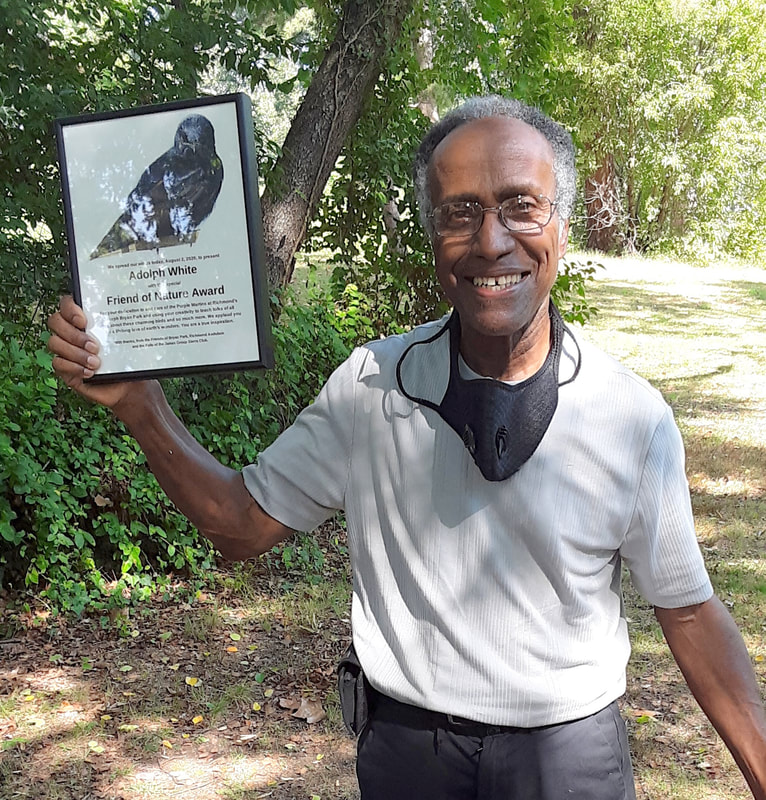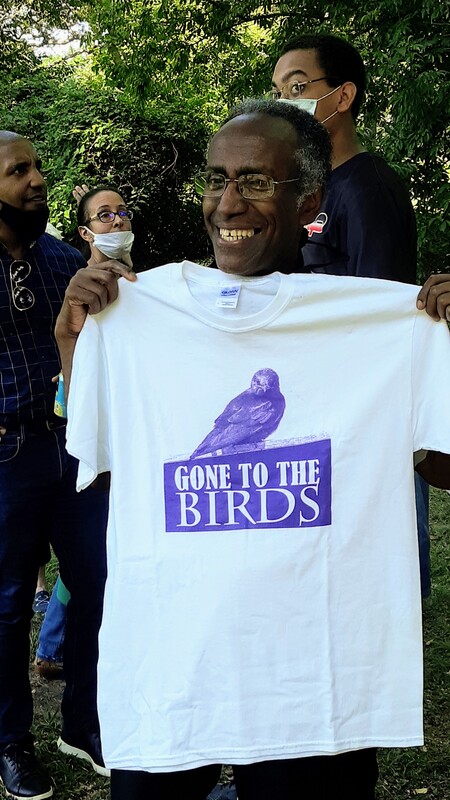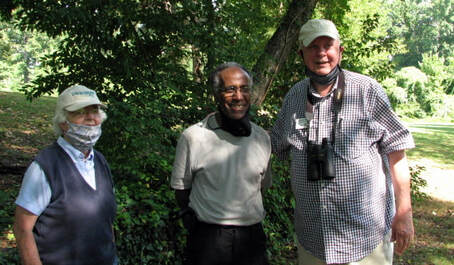 Adolph White got to catch up with Westminster Canterbury Retirement Community residents Anne Gray (known there as the “Bird Lady”) and Randy Smith, a Master Naturalist and Friends of Bryan Park board member. (Photo by Rex Springston)
Adolph White got to catch up with Westminster Canterbury Retirement Community residents Anne Gray (known there as the “Bird Lady”) and Randy Smith, a Master Naturalist and Friends of Bryan Park board member. (Photo by Rex Springston)
“I was basically a loner as a child and spent a lot of time touring through the woods and enjoying the birds, squirrels and other living things. Nature was my partner because I was a budding artist,” said White.
He could step out into a wild world that was “like a friend I depended on,” said White, who grew up in the Spring Grove community of Surry County, where his parents of six, Roosevelt and Ethel White, were sharecroppers.
“Walking in the fields or forest, I’d commit what I saw to memory. I’d take notes, or quickly sketch a scene, then run home and improve on my drawing.” White would ponder the patterns in leaves, snow drifts, clouds and stars.
He felt calm hearing cicadas sing in the pines. Intrigued at a snake disappearing in grass, he wrote a little story about that, but found his teacher was not as delighted.
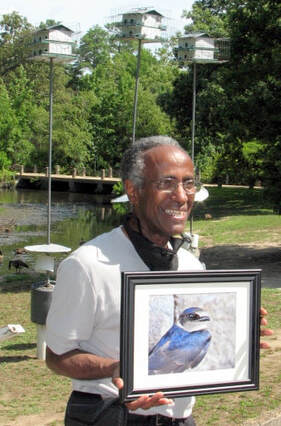 Purple martin landlord Adolph White talks about the successful colony under his wing at Bryan Park. He was given a portrait of a female martin taken by nature photographer Bob Schamerhorn. (Photo by Rex Springston)
Purple martin landlord Adolph White talks about the successful colony under his wing at Bryan Park. He was given a portrait of a female martin taken by nature photographer Bob Schamerhorn. (Photo by Rex Springston)
“Adolph is interested in everything pertaining to nature,” said Barbara Eck of Glen Allen, who has watched birds and explored the outdoors with him nearly weekly for about 15 years.
White, 77, reflected on his passion for the environment in summer phone chats, without a clue that friends he’s made along trails and watersides were about to honor him.
The retired Richmond teacher was given a Friend of Nature Award for his “dedication to and care of” the purple martins at North Richmond’s Joseph Bryan Park, and using his “creativity to teach folks of all ages about these charming birds and so much more.” It cheers his “lifelong love of earth’s wonders” and calls him a “true inspiration.”
This surprise awaited White when he joined the shade-tree social half of Richmond Audubon’s monthly bird walk at Bryan Park on Sunday, Aug. 2. It came with thanks from Audubon, the Falls of the James Group Sierra Club and Friends of Bryan Park.
“This is a heart-warming situation for me,” White responded, raising the framed award high for 10 relatives and 20 friends to see. A hawk print scarf had hidden it.
The sit-together was billed to White as a “happy travels party” for the park’s southbound martins, so he smiled skyward and said, “Bon voyage, purple martins! I will protect you next year… Nothing messes with my birds!”
Guests were amused to see his cute iPad animation of a martin leaving a house.
White has moved to Varina from Richmond to live with Demetria and her husband, Garland Johnson Jr., and their son, Garland Belton “B.J.” Johnson III.
White’s newlywed son, Adolph White Jr., and wife Porsche, enjoy having him for stay- over visits with them in Glen Allen.
“Dad loves nature, and nature loves Dad,” said Adolph Jr. He “reminds us” to slow down and “look at God’s beauty.”
Both grandsons, Keith Sutherland, 28, of Richmond, and brother, B.J., 21, benefited from their grandfather’s interest in school projects. He built a coop when Keith incubated chickens. White said, “B.J. is helping me make rain look real in iPad animations now.”
With his five siblings, White helped their parents garden and grow peanuts (actually legumes, he’ll add). A sister, Ruth Webb, and brother, Matt White, both of Richmond, were among family celebrating him at the park.
White was an avid young reader with good grades. A Sunday school superintendent, who had ties to Richmond’s Virginia Union University, appreciated that, and helped White secure a full scholarship there. He taught two years in Warsaw, Va., before becoming a Richmond city teacher and resident.
White gave middle-graders a good understanding of French and English, but people say he understands bird language pretty well, especially the many sounds of purple martins.
This spring, a 5-year-old girl was fascinated by the martins flying in and out of holes in three elevated “doll houses” White maintains by Bryan Park’s buggy Lower Young’s Pond. She agreed their chatter sounded happy, as parents fed chicks. She ran for her family to “come see the happy birds… the purple birds.”
That story made White laugh. Then he said, “I’m excited about how the martin houses tur
ned out. It makes me so happy.”
There were 27 residents this year. Adult males are iridescent blue-black with black-brown wings, and females are softer-toned with gray. Purple martins (Progne subis) sport forked tails, and their wingspans can top 16 inches. They are the largest members of the swallow family in North America.
White praises all the donors and volunteers who helped establish the park colony. Sadly, two partners have passed away. White found the late Wynn Price, a city parks specialist based at Bryan, to be priceless in his assistance.
“Jimmy and I formed a perfect friendship,” said White. They met one summer evening in 2008 in Shockoe Bottom under a sky full of swirling martins. Fitzgerald said the birds were “staging” — gathering to fortify on insects before leaving by summer’s end on a 5,000-mile flight to Brazil’s Amazon Basin.
Fitzgerald invited White to see his 160-martin operation on the Chickahominy River. White began to help him there and research martins like crazy. Soon, White was sharing information with martin spectators, who came nightly to the 17th Street Farmers’ Market for six summers to see 25,000 or so birds sculpt huge tornadoes and roller coasters.
Battalions of martins then swooped just yards overhead to claim branches in a line of leafy Bradford pear trees at dusk.
Richmond officials wanted to cut the old trees, in which the birds were first noticed roosting en masse in 2007. But bird lovers in 2008 organized the Gone to the Birds Festival that brought revenue to the city and diners to the Bottom through 2013.
White helped at the Purple Martin Conservation Association festival booth, and children flocked to him to hear about the migration.
He was even among early-risers hosing the poopy sidewalks all season after the hungry birds left the trees in the mornings to forage.
White recalled the crowd’s stir as Richmond’s rare peregrine falcons appeared at dusk. When a falcon caught a martin in air, the martins already tucked in the trees switched from a busy chatter to a “warning chorus that sounded like running water.” Redtail hawks going into the trees to get carry-out dinner caused a louder rush.
Such exciting nights and festivals ended when martins didn’t cluster downtown in 2014.
Before the gala at Bryan Park Aug. 2, only two or three chatty martins remained.
Typically, White sees the birds leave this pond site a few at a time until all are gone by July 31. These join a big group in the region preparing for the pilgrimage to Brazil. With family raising done, all can be leisurely, flying 300 miles a day. Their final destinations for fall in South America vary. They rush coming north to nab the best mates, nest sites and food. Masses can be seen on weather radar each way.
White said, “Just think, martins raised at our park this year are making their first trip!”
Friends of Bryan Park president and Master Naturalist John Zuegner thanked White for providing park visitors the opportunity to see the special birds raise families up close for 11 years.
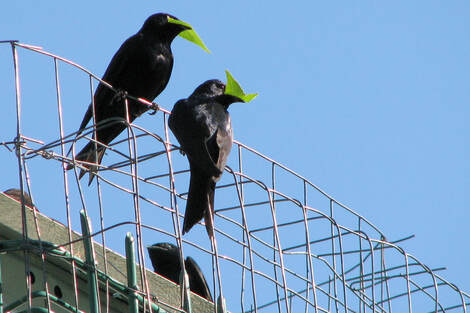 Martins with nesting material perch on one of White’s “wire porches” before slipping into a house safely out of any hawk’s reach. (Photo by Rex Springston)
Martins with nesting material perch on one of White’s “wire porches” before slipping into a house safely out of any hawk’s reach. (Photo by Rex Springston)
Sometimes, friends said, White looks like he is dancing to scare away house sparrows, nuisance birds brought to the United States from Europe in the mid-1800s, that will squash martin eggs, kill chicks and build their own nests on top of the carnage.
He repaired baffles that keep snakes from climbing the poles when his family brought him to the colony in July.
White has given up driving and can’t get to the park as often as he could when he lived 15 minutes away, but birders vow to help watch the colony.
Martins typically return to the park on March 15, if warmth brings ample insects to eat, he said. Martin caretakers must clean the houses and open the doors on time.
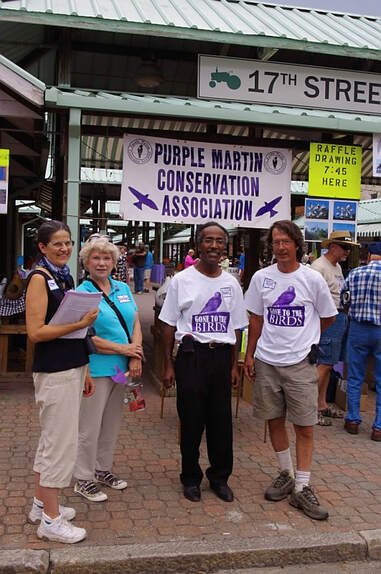 Helping at an early Gone to the Birds festival at Shockoe Bottom, from left, are birders Victoria Cooper, Barbara Eck, Adolph White and the late Wynn Price, a city parks specialist. (Photo by Natalee Tuck)
Helping at an early Gone to the Birds festival at Shockoe Bottom, from left, are birders Victoria Cooper, Barbara Eck, Adolph White and the late Wynn Price, a city parks specialist. (Photo by Natalee Tuck)
“He’s a very visual person,” said Diane Jadlowski of Montpelier, project committee chair of the Riverine Chapter of the Virginia Master Naturalists.
Jadlowski recalls a construction paper martin he made for his talk to Richmond Audubon members. “I can picture him in his English class helping his kids learn by color-coding words.” He told her he’d “make nouns red, verbs green and adjectives yellow.”
White’s programs using artsy diagrams at Bryan Park’s Nature Center were “popular and fun,” said Sue Ridd, the center’s former director and a festival organizer. He took detailed notes at friends’ talks on mushrooms, butterflies, wild edible plants and such.
Folks at Richmond’s Westminster Canterbury Retirement Community love White’s talks, too, said resident Randy Smith, a Master Naturalist and FoBP board member.
Teaching visiting Holton Elementary School children about Bryan’s martins and having
them draw together for several years “was so rewarding,” White said.
He hopes to show kids how to make nature flip-art books, maybe outdoors.
“With the coronavirus threat keeping youngsters home from school for months, parks like Bryan have been important,” he said. “Bringing kids out in nature makes them less stressful, gives them exercise and a break from television, smart phones and such. It helps their outlook.”
“Parks can acquaint and pull all types of people together,” White said. A 285-acre “haven,” Bryan Park is attracting visitors of many ethnicities this year, as “everybody needs to get out of their houses,” he observed.
“I was lucky to grow up in the country,” he said. “But city kids need to come to parks, where there’s something besides pavement, where they’ll enjoy the shade of the trees, playing on grass and being surprised by animals.”
Children frequenting parks “can see the world from an artistic point of view.” They just might be inspired to “pursue careers in science and help the environment”, he noted.
“When I was younger I thought the earth would exist as it was; I never thought of forests being destroyed… or about pollution.”
Art and science are connected for White. He teaches children to draw not just a tree, but the shadow it casts. “That’s a value the tree offers us.”
He wants children to learn the language of Mother Nature.
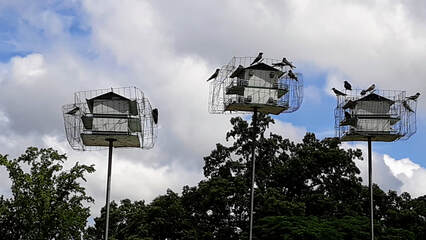 This year’s colony at Bryan Park. (Photo by Kathy Springston)
This year’s colony at Bryan Park. (Photo by Kathy Springston)
Go to www.purplemartin.org and learn how to follow along as the Purple Martin Conservation Association watches huge migration groups going south in August and September, with Roost Hunter Radar Tracking, using a National Oceanic and Atmospheric Administration weather and climate toolkit. See the birds return for spring the same way. At the bottom of PMCA’s site, click on Facebook or YouTube. Also see a February 2020 film made in Brazil, Purple Martins in the Amazon, and the NestCam video, The Secret Life of Purple Martins. PMCA: (814) 833-7656.

